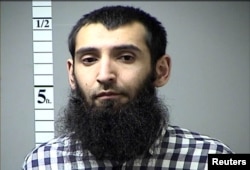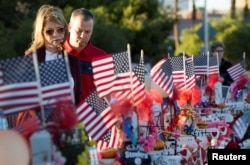An Uzbek national is accused of using a rented truck to mow down pedestrians on a bike path Tuesday in New York City, killing at least eight and injuring 12, in what Police Commissioner James O'Neill called "the worst terror attack in New York City since Sept. 11, 2001."
According to NYPD Deputy Commissioner of Intelligence and Counterterrorism John Miller, the suspect, Sayfullo Saipov, left handwritten notes pledging his support for the Islamic State group.
It's not uncommon following mass-casualty events like the Tuesday attack in New York City that people become confused about whether the incidents amount to terrorism. The U.S. government has a strict legal definition of terrorism, which the FBI describes as an attack motivated by "political, religious, social, racial or environmental" beliefs.
Due to Saipov's Islamic radicalization and his support for IS, authorities quickly labeled his attack as terrorism. After he used his truck to run over pedestrians, authorities say Saipov began shouting "Allahu Akbar," which means "God is great" in Arabic, and is commonly uttered by Islamic terrorists.
Other recent terror attacks in the United States include the 2016 Pulse Nightclub shooting, in which a radical Islamic terrorist, Omar Mateen, murdered 49 people at the gay night club in Orlando, Florida; and the 2014 Charleston church shooting, in which white supremacist Dylann Roof killed nine people in a black church in an effort to start a race war.
Both these instances were labeled terrorism due to the motives of the perpetrators. In the nightclub shooting, Mateen was driven to kill based on his radical Islamic beliefs. In Charleston, Roof targeted a black church due to his hatred of black people.
Race and terrorism
Despite U.S. legal guidelines differentiating terror attacks from other violence, it has not eliminated controversy over how attacks are classified.
Last month, Stephen Paddock opened fire on a crowd of spectators at a country concert in Las Vegas, killing 58 people and injuring an additional 546. Some politicians and members of the media were quick to label Paddock a terrorist, though his motive for the attack is still unknown, so it doesn't meet the official threshold to qualify as terrorism.
Hesitance on the part of authorities to label Paddock a terrorist, and the quick pace with which authorities labeled Saipov a terrorist, has led some to question whether race plays a role in the perception of terrorism.
This speculation on racial motivation behind the use of the word "terror" misses the point, however, as "terrorism" is used to describe the motivation behind an attack, not the attack itself.
Robin Lakoff, a linguist at the University of California, Berkeley, recently told National Public Radio (NPR) that while terror attacks and mass murders may "look alike on the surface; they're different underneath."
"Although acts of war, acts of crime and acts of terror can look very much alike on the surface, they have very different motives, very different reasons for being, and I think that's why people are confused," Lakoff, who has studied the language of war extensively, told the radio network.
In the case of Saipov, he was labeled a terrorist because of his association with a foreign terrorist group, while Paddock's motive is still unknown.
"[Saipov] appears to have followed, almost exactly to a 'T,' the instructions that ISIS has put out in its social media channels before with instructions to their followers on how to carry out such an attack," said NYPD Deputy Commissioner Miller, using an acronym for Islamic State.
















